
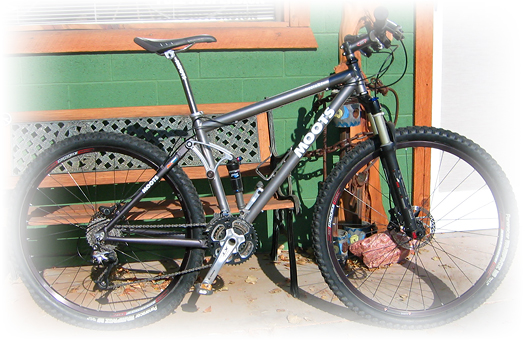
MOOTO-XZ PRODUCTION FRAME W/ DREAMRIDE BUILDS
2008 CUSTOM OPTIONS FOR MOOTS 29ER AND 69ER FRAMES
COMPLETE MOOTS MOOTO-X MAX BIKES | MOOTS MOOTO-X FRAMES
MORE 9ERS: DREAMRIDE POE | VENTANA EL CAPITAN | VENTANA EL REY | VENTANA EL PADRINO
IF SIX WAS NINE CONVERSION KIT | BIG WHEEL RANT
Testing our new Moots Mooto-Xz Dreamride Edition
As of April 2008, the review below is old news, but I keep it here as evidence that Moots' engineers have their ears open and that I am still doing the hard work for YOU!
This is a Moab trail test of a Moots Moot-Xz bike sent to us by the Moots factory folks. Based on an 18 inch frame, the bike out of the case weighed 29.75 pounds with the following components: Bontrager Race Lite Wheels; 2.35 Panaracer tires; 100mm Rock Shox Reba fork; Complete XT drivetrain and brakes; Salsa handlebar; Q stem; Moots seatpost; Goobi saddle.
First Impressions--November 27, 2007
The aluminum rear end is a fine, well-engineered item, but, to me the not-really-gray ano looks cheap on a ti bike. The blue/purple hue (really a black dye, but removed from the bath early to produce a pewter hue) doesn't add to the elegance of the arcing silver rocker and lustre of the ti frame. I'm truly being overly critical based on my own jaded (and educated) personal taste. And, Moots has reassured me that the rear end will be black in the production run (the frame tested is the prototype). That said, I just hate anodized finishes after dealing with them in the past on other bikes and as part of experiments we did for our own Fully bike, which was originally called the Rattler--with a rattlesnake anodized finish on it. It ain't a Moots issue here, really, but this frame costs enough to allow this sideline ano-criticism rant:
The reason manufacturers use anodizing over paint and/or peening or polishing is that ano costs a lot less and the public is in love with the marketing, thinking it costs more and builds a stronger frame (neither is true), so they are willing to pay more for an anodized bike. What a great opportunity to make money off of the stupidity of the mountain biking public! The marketing revolving around the strength issue only takes one thing into consideration--peening prior to anodizing compresses the surface layer of aluminum, making for a stronger tube overall, but then anodizing is an ACID bath, which then removes some of the surface to etch in the color,weakening the peening and ruining the tightest tolerances, especially if the part is re-anodized, a process that happens when streaks are noticed after the initital bath, causing the manufacturer to re-do the ano bath, which further removes more material, making the part weaker and causing, in the case of one manufacturer that we used to carry (they got cheaper and cheaper and cheaper, but the price went up, and up and up), a seatpost tolerance to be so bad that you had to spec a larger, custom post. Those frames were manufacturered by the same company that builds for Moots (see below). If you want to make a frame really strong, you peen and powdercoat, but that is expensive and no one wants to go that far because that eats into profits, especially if the public is so stupid as to think anodizing is "expensive."
It seems a bit absurd to go into ano's effects on the environment when titanium is so environmentally nasty that once you go that far for a sexy metal, you can just throw the Sandhill Cranes under the bus, forget the energy it takes, and the acids and toxins, and just keep riding with a smile on your face. So, I'll leave you to Google "aluminum anodizing and the environment." The aluminum rear section was fabricated for Moots by the Sapa Brothers in the Pacific Northwest, a company that originally specialized in anodizing. This fabrication house is the premier of its sort in America, building for Santa Cruz, Turner, Ellsworth, Ibis and other "manufacturers." We have carried three of the four mentioned, so anodizing has been on our radar screens for far too long. Moots is TRULY an in-house titanium manufacturer, by the way, so the farming-out of the rear section is way for them to work with a different metal. The Sapas do fine work for everyone. You cannot fault them, because they just build stuff for folks. Want to get started in the mountain bike biz with your own bike design? If you have enough money and an engineer to CAD up some drawings, folks like the Sapas will build for you, too, . . . and they will build your piece of crap just like you want it. It's your engineer that is the key, left to design it right, or screw up, whichever the case may be. Sapa will build the good or bad design with nice welds, fine extrusions, CNC work, heat treating and anodizing. The Moots rear end is well-designed, but I would have liked to see it done AT Moots in TITANIUM!, like the classic Smoothie. But, the length of those 29er stays and entailing flex of titanium would pose a very difficult problem to any engineer. Moots made the right decision to go with aluminum for this particular bike's ass end. But for the 26" wheeled Zirkel, it is truly a shame Moots doesn't have a full titanium version to offer.
I truly digress, at any rate, the rear end certainly seems stiff and strong enough. It doesn't have the lustre of the rear end of the Cinco, but it looks like it will do the trick and sometime in the future the color will be black, and we might see some powdercoat, if Moots is truly listening. Or, I might just grow to love the pewter look. It ain't so ugly that I wouldn't ride around on it. And it is stiffer than the titanium up front! It's all about the ride. The looks are important, but while I am riding the bike, I ain't lookin' at it.
I digress, once again, but who gives a damn about the environment, right? This is America! George Bush is president. We deserve the tailing pond, and if it weren't there, we might be speaking Russian. Putin enjoys HIS radioactivity, he even shares it with folks in their food. Let's keep it light!
The bike certainly handled like a Moots as I wove in and out of the trees through the wetlands. The bike was quick and agile for a 29er, though it was also very slow to accelerate. In a section of sandy, tight and twisty trail, weaving between a huge tamarisk and a Russian Olive pruned to resemble an array of pungi sticks. I ride this section on my rigid 69er (the very best bike design for this trail, by the way) with a shift to the back edge of the saddle and a smooth swoop of the bars. I performed the same body english with the Moots and the front wheel dug in like a limb had hooked my jersey. I reached out and grabbed a pointed Russian Olive stem to keep from being skewered. So, a very steep head angle combined 28 inch wide bars produces a somewhat clumbsy feel in tight stuff. Sort of like driving an MGB with power steering and a steering wheel the size of a garbage can lid. I thought of putting a larger tire on the front to raise the front end up for a slacker head angle, but we'll see about that later.
Once on the paved road along the Colorado River I came to realize that these tires were an absolutely horrible choice for this bike and this place. The true advantage of a 29er is the huge contact patch, but rubber can be overdone. It simply took too much energy to overcome the inertia of the heavy rubber and wind resistance of the paddle-like knobs on the 2.35 Panaracer tires. The steady rolling momentum of the large hoops was hard to create, let alone appreciate. And the damn saddle was starting to give me sexual dysfunction problems already. So about five miles from the shop, I turned around and took the singletrack back, determined to fix the bike and go for another ride. It was not my friend, yet. I must treat it better than it has been treated so far.
Back in the shop I swapped the tires for WTB Nanoraptor 2.1's, cut the bars down to 27 inches wide (stupid-wide, but my personal preference for Moab, and still narrower than they came to me!), and put an old WTB Power V ti saddle on the bike. This saddle went out of production because downhillers and freeriders were getting skewered by the flexy ti rails on jumps. I use these older Power V's almost exclusively for my own mountain bikes--they are the most comfortable saddles I have ever ridden--light and long, with a soft nose, so you can skoot forward for steep climbs. They are currently available in a newer model with narrower nose and steel rails (still an awesome saddle, by the way,--very popular on the rentals here).
After these changes I got on the bike and headed up Sand Flats Road to ride the slickrock, loose rock and sand above town. The smooth-bellied 2.1 tires did the trick on the pavement and worked like a charm on the rock and sand, too (the big contact patch turns a smooth belly into a gripping surface--with the right tire pressure). I was going a lot faster--and that is the mantra of all tests I conduct. If you go faster, smoother, more efficiently, remaining fresh during a long ride, then things are the way they should be. This ain't a contest to see what breaks first. It is a series of rides that point to changes that must be made to make me happy with the bike.
Here is the essence of 29erland: Don't overdo the rubber! Let rim width dictate width of the tire, and, if you are running 29 inch wheels front and rear, try to use as narrow a tire as you can get away with. Avoid big knobs unless you need them to hook up on slimy roots. Big knobs are heavy and blubber along on anything smooth, where you should be gaining and maintaining speed due to the big wheels. You'll go faster with smaller and/or smoother rolling tires and be a lot less fatiqued during and after a ride. A big fat tire is awesome on a 26er, and can be on a 69er, but when you combine the lack of availability of a suitable rim, the weight of the larger tire, extra wide casing and taller knobs, you have a wheel that is sluggish, hindering acceleration and climbing. And it can be a danger to you if that fat tire rolls over on that narrow rim. And, here is something to think of--before you find out the hard way: Large knobs and a huge contact patch combine with a steepish head angle and grip so hard that the front wheel will tuck under in a heartbeat in a tight situation. This will taco the rim if you tuck it hard enough. The Bontrager wheels on this bike are fine hoops, a welcome (and maybe the best) choice in a very slim selection of factory made wheels for 29ers, but they scream for a light, narrow tire (this has been the Bontrager cyclocross aesthetic all along, but there should be a warning on the rim to not put a motorcycle tire on it).
With the lighter WTB tires on the wheelset, climbing was a breeze. On the road I moved my hands onto the middle of the bar (I plan to put some bar tape on this area), slid my ass forward on the long saddle and spun away uphill. I was able to use the compression circuits on-the-fly and both ends of the suspension stiffened nicely for the climb. The bike now felt amazingly smooth and comfortable, accelerating at will. When I stood to climb, I could feel the Suspension Bob. I was still able to eliminate Bob with a higher pro-pedal setting. I'm a suspension guy. I don't really care about Bob much anymore. My legs naturally fight bob. I have a pro-pedal circuit in my calves. And, a bike with so little suspension to offer, really doesn't have enough bob to worry about whether or not the suspension design has enough alphabet soup in the patent materials. I just get into my "Bob" spin and happily pump up the hill, but some fine tuning worked like a charm on the Moots to eliminate Mr. Bob altogether.
Once off-road, I spent a few minutes on bumpy slickrock to see how the suspension worked in combination with the 29 inch wheels. The big wheels rolled over most of the small stuff without compressing the shocks much, but when larger hits came, the 100mm of travel smoothed out nasty bumps up to about a hand in height--almost like they were not there AT ALL. This is the reason to get a 29er: If you live in a place where the climbs are short and the trails are fast and covered with moderately bumpy roots and rocks, this bike is tops (if you fit the sizing window). The feel while riding over lumpy slickrock formations made me realize just which trail I was going to ride next--a very bumpy and twisty singletrack with surprise ledges and lots of slickrock moguls to hop over and bounce through. I rode this trail a few days ago on my Dreamride Mutant (a 6" travel All Mountain/Freeride bike that weighs 34 pounds). It will be fun to see just what unforeseen advantages and disadvantages crop up, but first I still had a couple of modifications to do on this bike.
I lowered the bars about a half inch. The next modification is necessary to enable me to ride more technical trails without cramped and tired hands.
The Colorado River Bridge on Highway 191
Years ago, when I began to ride the roads around Moab, a friend told me, "You are going to learn to hate 'The Bridge.' It will not be a good relationship. You won't know real fear until you have ridden it repeatedly and grow to dread it." That was a gross understatement. There have been several deaths on the bridge since I have been living in Moab. You grow to fear The Bridge above all spots on the road. Once I was approaching it from the north, attacking, to be able to cross doing around 45 miles an hour. I figured that if I was going the same speed as the car in front of me, it would be safer because no one could ride up alongside me on the extremely narrow bridge. If you meet an 18 wheeler coming the other way, you are in for a thrill. If you have one behind you, it is truly terrifying. So, there I was on the bumper of some tourist's rental car, streaking across the bridge, drafting, panting, pumping at maximum rpm at the same speed as the cars--the speed limit is 45mph. I was in the middle of my lane because I was right behind a car. I glanced over to my left and a car was PASSING ME! I had to slow down to let in get in front of me and behind the car I was drafting. This is so typical of stupid drivers--they just don't think of a bike as a vehicle. It is a toy that some idiot is riding on the damn road. So, this is why road biking is the most dangerous two wheeled sport--stupid people in cars! And this is why I drive past the bridge whenever I am riding north of town. But, once the bike bridge is completed, cyclists will be able to ride from Moab all the way past Arches National Park, get on the Old Moab Highway (OMH), which is blocked off to motorized traffic, and go forever in total peace, away from the gasoline stupids on the road and into the gasoline stupids on the trail. The OMH gets you all the way to Highway 313 and 4WD access roads that go everywhere in every direction. And, this, my friends, is the reason that 29ers are going to be seen more and more around Moab. They are the best ride-from-town bicycles imaginable and gas is not going to get cheaper! On the OMH the Moots felt like a best friend, smooth and comfortable, fast and encouraging. The climb out of the Valley was a chore on a 9er, but the bike was so comfortable and the new tires rolling so well that I was thinking all the way, "Damn, I am going to have to buy one of these frames! Ouch!"
Once I arrived on the old jeep road that leads further north, the technical challenges seemed tailor-made for the Moots. It is indeed fast on rolling terrain where the bumps are close together and less than a foot high. I tried to keep the speed up to take advantage of the rolling momentum of those big wheels. The suspension was icing on the cake. This bike is smooth, smooth, smooth over rolling jeep roads. Pure joy!
The first few yards on the rock were telling. All of the sudden the bike that was rock solid coming up the jeep road, rolling over the loose rocks,-- well it was not so rigid anymore. This trail has v-out transitions and off-camber turns over solid rock. These kind of situations tax your equipment. I could feel flex in the front fork more than anything else, but the front triangle was also reverberating nicely on hard hits, especially off-camber hits. I am going to recommend to Moots that they increase the diameter of the downtube on this bike. The length, shapes and bends of 9ers' downtubes are design challenges I have been watching manufacturers deal with over the past few years. It's like watching evolution. There is some stupid stuff going on in the realm of 9ers and some designs are wearing this stupidity on their sleaves--just look at the downtube. Moots is smart enough to avoid a bent tube or the need to use a jacked-up headset race to cover for a design flaw that allows the fork to impact the downtube. The headtube gusseting on the Moots is perfect, allowing for clearance of fork knobs and such, and it is STRONG. But, that said, on a suspension 9er, downtube flex is even more of a challenge due to the increased forces the tube must contend with combined with the length of that tube. All of our own Dreamride bikes (26 and 29) spec straight gauge tubing and external gussets on the downtube for the simple reason that resonance created by big hits causes thinner areas of tubing to flex noticably. It is a Moab thing. It is why we test bikes here and why the manufacturers we have worked with in the past and currently, take us seriously. Stuff breaks in Moab, or worst still, I get injured pushing equipment to its limit. Something that works just fine in Virginia, might collapse in Moab.
I hesitate to compare the performance of this 29er to the bike I last rode on this trail (my Mutant) because the comparison is like eggs and sponges, but it might have some value. The Mutant would not have been so pleasant on that climb up to this place, but it sure took all hits without flex or bounce or deviation of line. It also was much more positive in the tightest turns on very uneven surfaces, despite its comparatively slack angles and rear-biased rider position. The situation pictured directly below was not even a blip on the Mutant's radar. I have no memory of it on the Mutant, but on the Moots, this spot was indeed memorable. It puts a light on what is "bad" about the Moots Mooto-Xr (this bike's set up) and especially the Rock Shox fork.
Here is the rub: Not only are the Moots frame's titanium front section, Bontrager wheels and Reba fork flexy items, but the steep head angle is downright evil when GOING DOWN THE STEEPEST GRADES with your ass over the rear tire (drastically trying to get weight off of that steep front end) over lumps through tight turns. Going up, this obstacle is not nearly as nasty, except at the bottom of the first hump, if you do not hit it fast enough. There is a moment on a short climb up an obstacle like this when you hit the gap and the wheels stop rolling. On a 29er you have to create motion out of the v-gap with two very large rolling hoops. This is where you feel the big negative of 29 inch wheels--getting them rolling from zero on the way up a very steep grade. I do not like that feeling because I herniated myself doing just this sort of manuever on a heavy freeride bike. Hernias require surgery and a lifetime of aches. 29 inch wheels feel like that freeride bike in the bottom of the V--when you are going up it. If you have a hernia, you understand. If you never got one, you can, if you just find the right grade and the right gear and the right weight bike.
But, I digress, once again.
The real issue: What you feel going down this little turn on the Moots is far more disturbing, however. First, I have to say that I hate to have to be so critical, but I must be honest and tell you that I feel the Moots, while it IS a mountain bike made in Steamboat Springs, Colorado where climbing in the high mountains on steep trail over roots is the big deal,--well, the head angle is about one degree too steep for the Reba fork and the kind of riding pictured here. I'll bet that it doesn't work so well coming down those tight singletracks in Steamboat, too. I can forgive the steepness, if I get a fork with a longer axle to crown, swap the front tire out for a larger casing (this is coming in this test, by the way) or just order up a custom head angle. On the way down this section of trail (it is steeper than it looks, remember) the fork compresses because you are braking for the hard right turn on a descent that takes you into the left turn into the v-out. A lot of weight, even with your ass over the rear wheel, is shifting to the front end. This means your head angle is now around 75 degrees. This is where and how wheels, especially 9er wheels, tuck under and taco!
And then, once you make that tight turn at the top, you have more work to do. Notice the lumps and bumps in the route. In a straight line, squared up to obstacles, this Moots 9er rolls over these bumps with no problem and could do it nicely with no suspension at all, but in a turn on a hill over bumps, a flexy 9er does weird shit--all those flexy parts--the wheels, the fork, the titanium front section of the frame--flex, and the bike ends up initiating a series of un-asked-for turns, turning in directions you do not want to go. To reign the bike back into control, you have to go slow, slow, slow, all the while trying not to let one of those bumps stop you dead in your tracks. And you have to go slow from the start! If you grab brakes hard into the obstacle, all the negative effects of front suspension compression come into play once again. This little descent had me making all kinds of little wobbly corrective maneuvers, fighting the bike all the way down. Even if I could make it look smooth, it still raises the hair on your arms.
On my way back to the gasoline-powered vehicle support (that got me over that damn bridge), I noticed that I was off the upper section of jeep trail in relatively quick time. My time on the trail and the jeep road were almost the same as with the Mutant. The Mutant did the really twisty and bumpy stuff much more capably, and really flies on the downhill, but on the rolling stuff, it is heavy. The Moots made the rollies very short, and the more slight uphill grades were hardly noticed. Time-wise in the overall picture of this ride, the two bikes are fairly equal. Most bikes, like most people, have their flaws and good features. To some people a feature can be a flaw, to others a positive trait, and vice versa. To me, the Moots's advantages far outweigh its disadvantages in this area of the world. Getting to know this bike, I am becoming more and more convinced that the Mooto-Xr has its place as the best full suspension 9er you can get, despite its inherent drawbacks--from the mere fact it is a 29er at this point in time. I cannot imagine a better ride-from-town rig that can actually handle the trails when you get there. I have been riding a rigid 69er for those rides done from town. It works just fine, but the Moots is far more capable off-road with its suspension parts. Of course, those suspension parts come with some responsibilities in the maintenance department. The rigid bike never needs work! Like I said, advantages and disadvantages. As time progresses, we get more and more choices. Ain't life grand?
Which brings me to the fork, again. I don't particularly like this Reba fork, though it is certainly the best 29er fork out there right now. It is smooth-operating, but oil is constanting leaking from the top seals, attracting sand which is then taken into the seals to rough them up even more to allow more leakage. It is way flexy and the solution involves adding weight, so we won't see this corrected due to the amazing number of anal weight watching fools who buy stuff based on phony numbers. Marzocchi will eventually do one of these right, but like Mavic, who will eventually give us a double eyelet rim that will tension up to stiffen these 9er wheels, they are waiting for a big jump in sales that will spark OEM sales. It ain't happening yet.
Now, everything is fine!--December 3, 2007
The tire change and resulting slacker head angle (71.5 degrees without sag--is still steep) meant everything to this test. With the handling of the bike under control, I was inspired to ride a bit harder to do some tests to see how the rear suspension was working over obstacles, under braking, and under lateral load across bumps and uphill.
I drove the bike up to the same slickrock route. Within a few yards the difference was appreciated. I was able to hit larger obstacles without radically moving my weight far, far back for safety. Once on the rock the difference was like day and night. I am now in love with this bike. I sped around the rock loop, stopping only to take a couple of pictures.
The twisting descent with the gap at the bottom that was frightening before was now a simple technical maneuver. I got my weight back, shifted it slightly at the hips, turned the front end and the bike railed along the line marked on the rock. I was able to square off little hits along the way with ease because the handling was much more intuitive and natural for me.
There is a spot on this loop with a long downhill to gain speed, then a very bumpy ascent over off-camber rocks and gaps. I probably reach 25 miles an hour before I hit the bumpy uphill that eats your momentum as your impact the rocks, then you shift gears. This is a place where most full suspension bikes will ghost shift. There is one suspension bike that was king of non-ghost shifting on this spot over the past few years. It was the Moots Smoothie. Since I sold that full ti Smoothie a couple of years ago when the model was discontinued, I had forgotten just how efficient the simple arcing rear suspension design is. The Mooto-Xz has a variation of the arcing design that is now designated as "Zirkel." This has to be the perfect design for travel under four inches and I say this because I could not get the bike to ghost shift even in slightly funky gear combos. This bike loves to put the power of your pedal stroke into the rear wheel and I cannot say enough good things about the lateral rigidity of the rear end of this bike, even if it is a 29er. The reason this design works so well is, unlike other suspension designs with a seatpost mounted rocker, the Zirkel rear end has no rear axle pivot, which keeps the rear end extremely rigid. The downside of the new Zirkel rear end, if there is one, is a rising rate to the damping, mostly due to the placement of the shock, but I was able to tune the Fox Rp23 to match the action of the rear end almost perfectly. I ran it a tad stiff. If I wanted plushness, I would be riding a six inch travel 26-inch-wheeled bike. For a 9er, the travel on the Mooto-Xr is awesome and setting the suspension up stiff just increases its efficiency! I wouldn't want more travel on a 9er, because lateral flex of the big wheels fights benefits of longer travel. And, frankly, there ain't a lot of room for more travel on a 9er. I am sure companies will put more travel on a 9er, but, frankly, that is somewhat irresponsible considering the current state of componentry. Innovation is great, but it can be goofy, too.
When I first rode this trail on the Mooto-Xz I thought that some of the funkiness in the tight handling on a descent might arise from brake jack, but once I tested the frame for this, I found that the brakes hardly had an effect on the rear suspension. The arcing design works like a charm. Any brake jacking I was experiencing was a direct result of head angle and fork dive. Once the weight moved so far forward, the rear end just didn't have any weight on it, so naturally it came up. With the fatter tire and resulting change in handling, that feeling went away because I was able to get weight off the front wheel.
Before I sign off, I have to say something about the fork: Moab locals don't ride Rock Shox forks, unless they are given to them. Why? . . . Sand! That's why. The seals weep oil and the oil picks up sand. The sand is carried into the top of the seal and the seal becomes scuffed and the stantions take a beating around the seal. The forks people choose out here are almost invariably Marzocchi because the seals are immaculate, the line is vast and the forks are insanely reliable and stout. Too bad Marzocchi is not producing a 9er fork right now. Fox is beginning to offer one at this point, and I hope it is better than this Reba, and has a longer axle to crown measurement, but my experience with Fox is that their seals are not-so-hot, either. This Reba tunes up nicely, but it is flexy, cheap looking, and weepy. I guess the one-word review would be "disposable." And, more importantly, the axle to crown measurement does not match up with this frame in my opinion. The frame is fine the way it is. One thing about a steep head angle--if you like a high bottom bracket (I DO!)--you can always get a slacker angle with a longer fork, a bigger tire up front or a custom headset race. If you want a lower bike, there are plenty of them out there, but not in Moab.
Looking at it:
The truly immaculate welds and tightly mitred tubing on the frame maintain the standards Moots is famous for! After giving up on trying to adjust the angle of the very uncomfortable Koobi saddle with the new Moots seatpost design, I just put an older Moots seatpost and WTB Power V saddle on the bike. Later I called Moots and was told how to adjust the new seatpost. It is beautiful, but I still hold affection for the older design. The Bontrager assym rims came pre-dented, but are a truly smart and beautiful design---and way too narrow for heavy 2.35 tires that came on the bike. The Salsa handlebars were way too wide for the steepish head angle, ugly and cheap looking, but they do have a nice sweep. That said, I do NOT trust Salsa components after testing their 9er rims and finding them downright dangerous. The Shimano XT parts are flawless, as always.
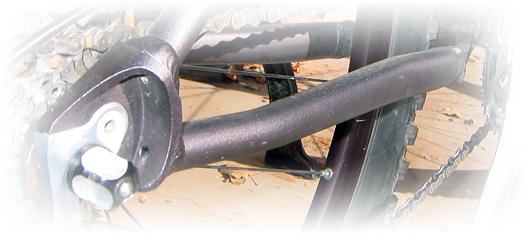 As soon as the bike was together, I took it on the singletrack through the flood plain that starts behind our shop and leads to the Portal and onto Kane Springs Road. I went fast right out of the shop, streaking through dog shit and thorns through the wetlands parking lot where environmentalists park their huge SUV's to hike the wetlands next to one of the most polluted spots on the continent, the Atlas Tailings Pond. The river is dead, the fish are dead, and you can be dead, too, if you hang out next to that pile for too long. It is highly radioactive, but the real nasty stuff are the chemicals in the pile that were part of an experimental process to process uranium rapidly on-site.
As soon as the bike was together, I took it on the singletrack through the flood plain that starts behind our shop and leads to the Portal and onto Kane Springs Road. I went fast right out of the shop, streaking through dog shit and thorns through the wetlands parking lot where environmentalists park their huge SUV's to hike the wetlands next to one of the most polluted spots on the continent, the Atlas Tailings Pond. The river is dead, the fish are dead, and you can be dead, too, if you hang out next to that pile for too long. It is highly radioactive, but the real nasty stuff are the chemicals in the pile that were part of an experimental process to process uranium rapidly on-site.

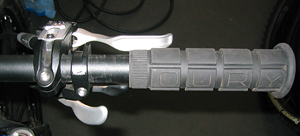 One of the features of this bike's set up was particularly uncomfortable. I am used to one-finger braking. I set up every bike I build for one-finger braking to enhance an ergonomic cockpit and give some wiggle room around the levers. Stock XT shifters and brake levers cramp the control area around the grips, putting hands in one position for shifting and braking, taking up more fingers than needed, and not allowing a firm grip on the bar while braking and shifting. So, I eliminated the shifter windows and moved the pods outboard (toward the grip) of the brake levers. This is an easy proceedure. Simply remove the windows by releasing tension on the cables and unscrewing the tiny Phillips head screws that hold the windows on the pods. Inside the removed window assembly there is a black cap that snaps off and onto the pod to cover the innards. It is then secured by a screw over the cavity. There are two allen bolts on the shifter assembly that allow you to move the pod further away from the grip. Use Lock-tite. The new set up is much more comfortable and far more efficient, but you will no longer be able to look down at your shifters and know where the chain is on the gears. XTR shifters come stock without the windows and are easier to modify out-of-the-box. Thanks, Shimano, you evil corporation, you.
One of the features of this bike's set up was particularly uncomfortable. I am used to one-finger braking. I set up every bike I build for one-finger braking to enhance an ergonomic cockpit and give some wiggle room around the levers. Stock XT shifters and brake levers cramp the control area around the grips, putting hands in one position for shifting and braking, taking up more fingers than needed, and not allowing a firm grip on the bar while braking and shifting. So, I eliminated the shifter windows and moved the pods outboard (toward the grip) of the brake levers. This is an easy proceedure. Simply remove the windows by releasing tension on the cables and unscrewing the tiny Phillips head screws that hold the windows on the pods. Inside the removed window assembly there is a black cap that snaps off and onto the pod to cover the innards. It is then secured by a screw over the cavity. There are two allen bolts on the shifter assembly that allow you to move the pod further away from the grip. Use Lock-tite. The new set up is much more comfortable and far more efficient, but you will no longer be able to look down at your shifters and know where the chain is on the gears. XTR shifters come stock without the windows and are easier to modify out-of-the-box. Thanks, Shimano, you evil corporation, you.
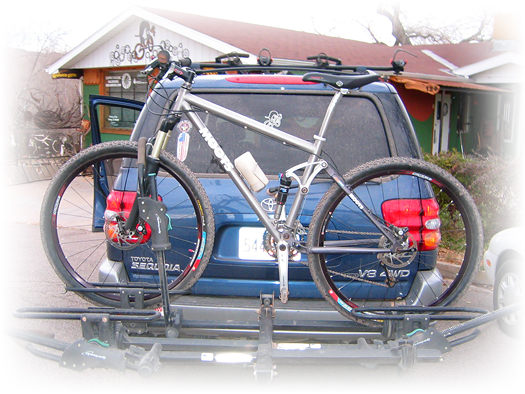 2nd Impressions--November 29, 2007
2nd Impressions--November 29, 2007
Today, I took the Mooto-Xr out of town for a ride on a newly marked trail over a section of Moab Entrada Slickrock Tongue, the most wonderful geological formation on Earth for mountain biking. I know this particular area very well and have been riding here over the past fifteen years almost weekly, for fun and professionally. The marked route is already causing the environmental quality to degrade. This is typical in Moab with a neverending barrage of clueless and skill-less riders flocking to Mecca without a clue as to why anyone would get upset about a mountain biker riding on "dirt." The "dirt" I speak of is our own variety--known as cryptobiotic soil crust--a living colony of plants and bacteria that form a thin crust over the drift sands in this subdesert climate, and then create the nourishment needed for other fauna to develop. It is the basis of all life out here. A good formation of it takes around 200 years to develop, and destroying it means that the area will remain scarred and/or barren for many decades. I have been riding this specific area for many years and I have never left a real track (and if I, or a client, do make a mark by accident on any area like this, I always take the time to "fix" it). Now that this route is marked, there are growing numbers of tire tracks from riders who loose the route (it is easy to loose the line), chicken out at the easiest of obstacles (the hardest obstacles on this route are just bumps), or simply take off on their own on foot or on the bike to destroy crypto many yards off the trail (usually to pee behind a bush, so no one will see how pathetic their penis is). I hate to see the destruction of this area, but the marked route is a lot of fun. Before, when I was riding this area alone or with a friend or client, we were always hopping on and off the bike to avoid leaving marks. It is a wonderful game, actually, and I have a few slickrock areas very similar to this place permitted where I lead clients through nature without leaving a trace. It requires a lot of concentration, serious thinking ahead and a good short term memory, but it is a lot of fun and increases mileage greatly. It increases mileage because you are constantly looking for clean transitions, hoping up ledges and riding along little ridges of rock, all the while thinking of the move you must make five moves away. It is not something I take less experience riders into and this technique is lost on most riders. You must be able to follow a tight line, at any rate. This new route marked on the rock mimicks my riding technique and I have ridden this area so much that I get a deja vu every fifty feet or so, so I would not be surprised if the authors of this trail know me and have ridden with me. If that is so, I must pray for forgiveness. Meanwhile, I ride the trail, and I no longer have to hop nature's fragile live obstacles, because they are obliterated wherever the evil trail builders decided to take us. The route tries to avoid more obvious sections of crypto, but wherever it exists and in the way, it dies for the sake of this trail. The authors of the trail certainly do not understand the blackened water pockets on the rock that support desert shrimp. They marked the trail right through them whenevever they are in the way. It is a shame. It would be a really good idea to run the trail around the blackened pit simply for the sake of educating others as to their value as ecosystems. But the damage is done, so I ride smoothly, never getting off the bike, free of guilt of having done this damage myself (unless the authors are those turds from Aspen who have condos in Moab, who I took out there a couple of years ago). At some point, if we are not made extinct by disease and famine before it happens, the entire planet will be manicured for us to use like our bitch.
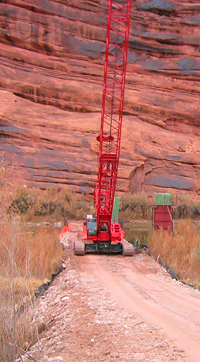 This trail is mostly on rock, but includes varying surfaces on the way to it. The Moots really shined over paved roads, bike paths, and the old rolling jeep trail. Moab is becoming a place where a 29er is very advantageous as transportation AND recreation. Pictured to the right is construction of a new bicycle bridge over the Colorado River about a hundred yards east of the existing bridge north of town. Once the bike bridge is finished the greatest obstacle to riding north from town will be eliminated.
This trail is mostly on rock, but includes varying surfaces on the way to it. The Moots really shined over paved roads, bike paths, and the old rolling jeep trail. Moab is becoming a place where a 29er is very advantageous as transportation AND recreation. Pictured to the right is construction of a new bicycle bridge over the Colorado River about a hundred yards east of the existing bridge north of town. Once the bike bridge is finished the greatest obstacle to riding north from town will be eliminated.
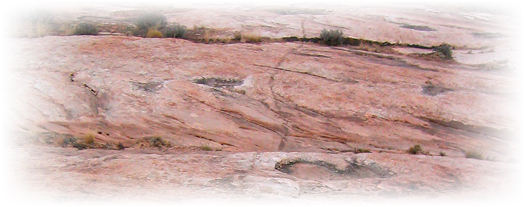 I arrived on the rock; the surface I ride 90% of the time; the surface that is unforgiving and hard, hard, hard; the surface that talks to me about lateral rigidity and overall strength. Now, I was to ready to really find out about this best example of a full suspension 29er.
I arrived on the rock; the surface I ride 90% of the time; the surface that is unforgiving and hard, hard, hard; the surface that talks to me about lateral rigidity and overall strength. Now, I was to ready to really find out about this best example of a full suspension 29er.
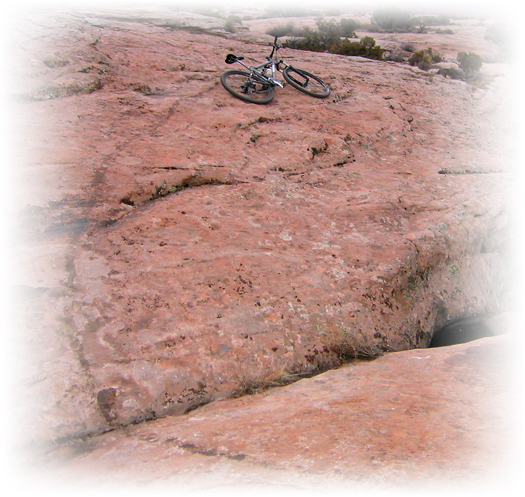 This spot, like all the pictures of this place, just doesn't look as steep or as dangerous as it really is. If you miss the tight turn coming down from the top, you end up in large crack, falling about 10 feet onto nasty rock that would hide your body from passing stangers. In the picture you can see the marked trail arc just above the rear tire of the bike. This sweeping turn coming down is as easy as pie on our 6" travel bikes. On the Moots it's scary, and dangerous. This is how adventure happens, right?
This spot, like all the pictures of this place, just doesn't look as steep or as dangerous as it really is. If you miss the tight turn coming down from the top, you end up in large crack, falling about 10 feet onto nasty rock that would hide your body from passing stangers. In the picture you can see the marked trail arc just above the rear tire of the bike. This sweeping turn coming down is as easy as pie on our 6" travel bikes. On the Moots it's scary, and dangerous. This is how adventure happens, right?
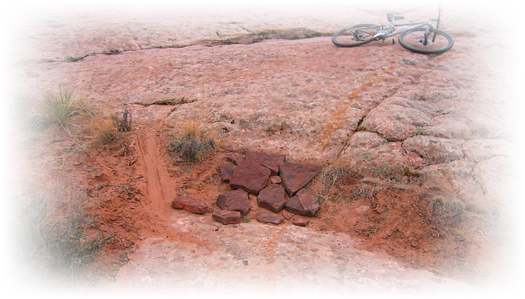 Once past this obstacle there were only a couple of tight turns that again confirmed my distain for the head angle. The rest of the trail, especially sections where I could straighten out the wheels before attacking an obstacle, was quite easy for the bike. After a couple of hours of twisting around, pedaling over ledges and lumps and through off-camber turns, taking pictures and admiring the bike, I was back on a jeep road again. I had only whacked a pedal once! The bottom bracket height on this bike is awesome! I noticed that I had not bottomed the suspension, using about 90% of available travel front and rear. I guess I am saving that final 10% for that "brain fart" moment.
Once past this obstacle there were only a couple of tight turns that again confirmed my distain for the head angle. The rest of the trail, especially sections where I could straighten out the wheels before attacking an obstacle, was quite easy for the bike. After a couple of hours of twisting around, pedaling over ledges and lumps and through off-camber turns, taking pictures and admiring the bike, I was back on a jeep road again. I had only whacked a pedal once! The bottom bracket height on this bike is awesome! I noticed that I had not bottomed the suspension, using about 90% of available travel front and rear. I guess I am saving that final 10% for that "brain fart" moment.
Today the weather broke. I woke up, went over to the shop, and performed the most important change to this test bike. I took the front wheel off of my personal Dreamride White Rim 69er and put it on the Mooto-Xr. The wider WTB Laserdisc rim on this wheel allows a 2.55 tire--barely. Since the wheel was built here, I have a bit more trust in it. This particular WTB tire is very light for its large casing due to the use of small knobs, kevlar bead, relatively thin side walls and a rounded profile. This tire has become my favorite for Moab terrain, excluding extreme bikesurfing that requires larger and stouter knobs with some kind of stepped support. The Weirwolf 2.55 rolls fast and floats over sand and small bumps.

Copyright Dreamride LLC. No material, written, graphics, or photographs on this website, may be reproduced, broadcast, published, re-written, re-edited, or re-used in any way outside of this site without written consent of Dreamride LLC and Lee Bridgers. Use of this site signifies agreement to terms of use.
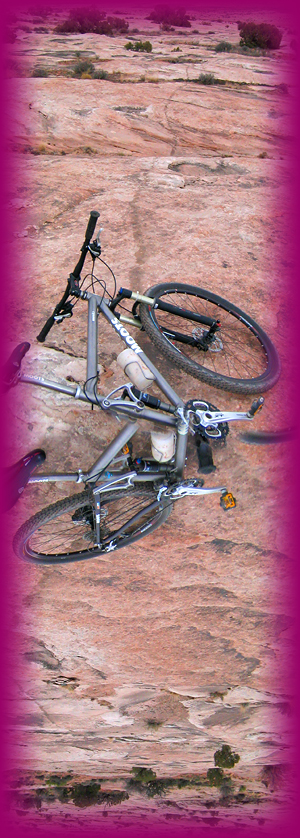 The trail I chose to test the proto is mostly rock, fairly technical and only a few miles from town. My elapsed time on this seven mile loop was shortened by about 15 minutes with a simple tire change. Subtle changes in geometry and set up make a huge difference in the performance of a 29er. And, it changes with body size and type.
The trail I chose to test the proto is mostly rock, fairly technical and only a few miles from town. My elapsed time on this seven mile loop was shortened by about 15 minutes with a simple tire change. Subtle changes in geometry and set up make a huge difference in the performance of a 29er. And, it changes with body size and type.
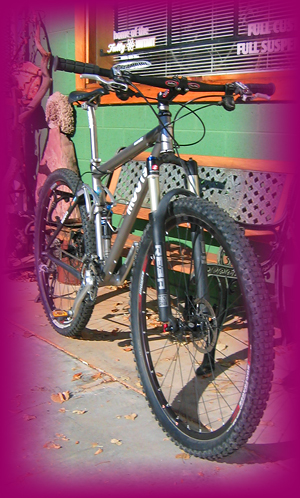 It looks sweet! This picture was taken after putting the bike together as it was sent. Changes that were made to this set up during the test were: Shifters moved inboard of the brake levers for one-finger operation; Handlebar was narrowed by 1"; Seatpost and saddle were swapped out for comfort; Tires and front wheel were swapped out for smoother rolling resistance and to slacken the head angle for more technical Moab riding. After the changes, the bike became a good friend.
It looks sweet! This picture was taken after putting the bike together as it was sent. Changes that were made to this set up during the test were: Shifters moved inboard of the brake levers for one-finger operation; Handlebar was narrowed by 1"; Seatpost and saddle were swapped out for comfort; Tires and front wheel were swapped out for smoother rolling resistance and to slacken the head angle for more technical Moab riding. After the changes, the bike became a good friend.
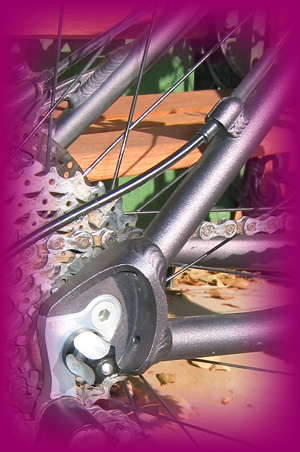 The dropouts are truly burley. No flex here. The long tubes of the swingarm assembly (chainstays and seatstays) are amazingly stiff considering how thin they look as they span the distance necessary for 29 inch wheels.
The dropouts are truly burley. No flex here. The long tubes of the swingarm assembly (chainstays and seatstays) are amazingly stiff considering how thin they look as they span the distance necessary for 29 inch wheels.
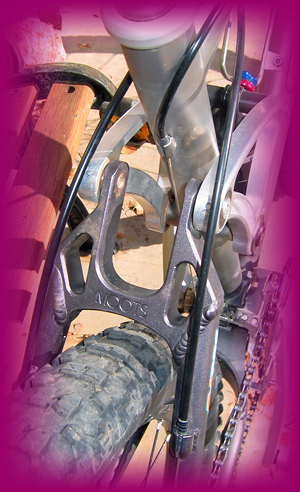 The rockers and swingarm assembly and very nicely designed. The rear end of the bike is much stiffer than the front section, so you can pretty much forget about it and ride within the limits of the titanium. Nice work!
The rockers and swingarm assembly and very nicely designed. The rear end of the bike is much stiffer than the front section, so you can pretty much forget about it and ride within the limits of the titanium. Nice work!
 This is what Moots does: Perfect welds. Perfect miters. In house titanium fabrication. And they let us customize stuff. We love Moots.
This is what Moots does: Perfect welds. Perfect miters. In house titanium fabrication. And they let us customize stuff. We love Moots.
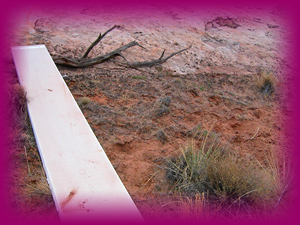 The trail builders put a diving board across a section of cryptobiotic soil. Preservation of the natural habitat could have been achieved by routing the trail around this stuff (it is possible, and would put some technical moves into this section), but, Duh. A diving board looks kind of out of place on this rock formation and the crypto around it is doomed at any rate--because most mountain bikers don't even know what crytobiotic soil is and most will not care at any rate (the sad state of the American mentality when it comes to things that are not "me" includes mountain bikers). Next will be ramps. Look out.
The trail builders put a diving board across a section of cryptobiotic soil. Preservation of the natural habitat could have been achieved by routing the trail around this stuff (it is possible, and would put some technical moves into this section), but, Duh. A diving board looks kind of out of place on this rock formation and the crypto around it is doomed at any rate--because most mountain bikers don't even know what crytobiotic soil is and most will not care at any rate (the sad state of the American mentality when it comes to things that are not "me" includes mountain bikers). Next will be ramps. Look out.
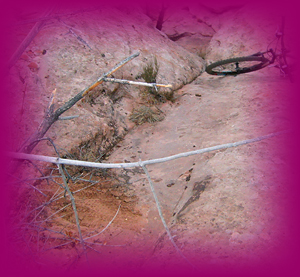 The front tire is next to the marked trail, which hops up a v-out. The tire marks are NOT GOOD, but the trail is quite difficult at this point and the damage to the mosses and soil crusts must be expected, if you make the trail too hard for Betty and Barney. Blame it on the trail-builders who obviously have just enough environmental awareness to know that they should stay on the rock, but don't imagine just how lame the riders are that come to Moab and jump into deep end of the pool with their water wings on and find that rock is hard and a different kind of wings can be had.
The front tire is next to the marked trail, which hops up a v-out. The tire marks are NOT GOOD, but the trail is quite difficult at this point and the damage to the mosses and soil crusts must be expected, if you make the trail too hard for Betty and Barney. Blame it on the trail-builders who obviously have just enough environmental awareness to know that they should stay on the rock, but don't imagine just how lame the riders are that come to Moab and jump into deep end of the pool with their water wings on and find that rock is hard and a different kind of wings can be had.
It is truly amazing how such a subtle change in head angle can radically change the effective handling of a 29er. I learned this the hard way, by designing my own 29er, which evolved into a fully rigid 69er with a 69 degree head angle and a 26 inch rear wheel (we can use our drawings to have Moots custom fabricate a Dreamride 69er for you). The Mooto-Xr is simply the best full suspension design for a 9er. It is SANE! I think that is the best word for this bike. Longer travel is a bit crazy at this point in time. Less travel is covered by the YBB Mooto-X. The standard Mooto-X is a hardtail. Rigid is possible by using our geometry and having Moots fabricate a frame. The most exciting possibility is the ability to put a Zirkel 26 inch rear wheel set up on the back end of a 9er front section. It's all there.